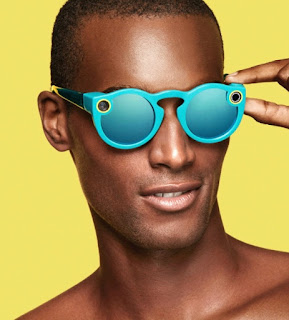A spectacle of yourself:
Snapchat’s vision for everyday people
The story was first widely reported in The Wall Street Journal.
The glasses, called Spectacles (they got a trademark for that name?), give viewers the opportunity to make 10-second videos that are then uploaded via wi-fi connection to the wearer’s Snapchat account.
How it works: Spectacles record video when you tap a button near the hinge, with each tap recording 10 seconds of video footage — that consistent with the basic unitary Snapchat time frame. The 115-degree-angle lens was apparently intended to give a wider view than smartphone cameras, one more consistent with human vision, The Journal reported.
◊ ◊ ◊
The big factor here is their wearability. As shown on the Spectacles web site home page, the glasses ($130 a pop) are fashion-forward enough to be wearable every day without looking like an escapee from a Kraftwerk video, a la Google Glass. They don’t look that much more outlandish than other, non-video-enabled sunglasses. The video will sync up wirelessly to an iPhone or other smartphone, The Journal reported.
Snap plans a slow rollout of the product, no doubt taking a cautionary page from the Google Glass debacle. Spectacles will launch this fall in three colors: teal, black and coral (if iPhone sales are any guide, look for the black to sell out first).
What Snap certainly achieves short-term is reinforcement of the interoperability of the Snapchat experience (and use of its app) ... and a stronger sense of Snapchatters as their own highly mobile, upwardly-mobile visual community — pretty much consistent with Snapchat’s avowed mission to reshape the way we view photography.
◊ ◊ ◊
Some quarters are already losing their shit about Spectacles. Recode just went into Chicken Little mode about the devices: “Why aren’t people freaking out about glasses that watch everything you do, all the time?” the tech site tweeted Saturday.
The answer is simple: If you’re not wearing them, you’ve made the choice not to use them ... so what is there to freak out about? Like most of the technology that matters in our lives, its ubiquity is often situational. The GPS in your phone can’t track you if you don’t take the phone with you.
◊ ◊ ◊
WHAT'S more provocative in a positive way is the role Spectacles could play in resolving questions and disputes in street encounters between police and ordinary American citizens. They’d be one more easily accessible visual-recording device citizens could use to confirm or deny statements made by police in altercations. Especially the potentially deadly ones.
 This year has been especially ugly on that front. Several high-profile encounters have left citizens dead at the hands of police in often disputed circumstances. Imagine a crowd of onlookers, by happenstance at the scene of a potentially deadly encounter, that included two or three people making videos of the event with Spectacles at slightly different times and from different perspectives — in addition to the cellphone videos almost certainly taken at the same time.
This year has been especially ugly on that front. Several high-profile encounters have left citizens dead at the hands of police in often disputed circumstances. Imagine a crowd of onlookers, by happenstance at the scene of a potentially deadly encounter, that included two or three people making videos of the event with Spectacles at slightly different times and from different perspectives — in addition to the cellphone videos almost certainly taken at the same time. Spiegel has called Spectacles a “toy,” in an understatement I hope he uttered in jest. In ways that Snap Inc. may not even envision just yet, Spectacles could play a deadly serious role in police-community interactions as another dispositive visual aid in finding out What Really Happened.
◊ ◊ ◊
Snap CEO Even Spiegel told The Wall Street Journal that he views Snap as a camera company, rather than a social-media company. Sure, he can say that now, now that he’s actually got cameras to sell.
But when Spectacles go on the market, and once the product meets the real world and its myriad applications for this, Snap may find it can’t so easily divorce itself from its social-media identity.
The camera was, in many ways, one of the first true social-media devices. Photography has a built-in purpose of sharing; there's an implicit reliance on community with cameras (and the photos that come out of them). Spectacles won’t end that relationship with social; they’ll enhance it. And what people share with Spectacles will certainly go beyond what their creators intended, in ways that could save more than just memories.
Image credits: Snapchat logo, Spectacles logo, still from Spectacles web site: © 2016 Snap Inc.




.jpg)
Comments
Post a Comment